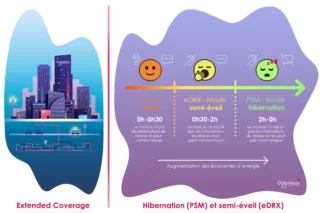Discover Objenious’ Innovations
From full-size SIMs to nano SIMs, the evolution of SIM cards over the years highlights their importance of connected devices. Also known as an integrated or embedded SIM, the eSIM is placed directly among the components of connected devices. eSIM offers a dematerialized service that digitizes the SIM card update process.
Today, eSIM is widely used in the automotive industry, as it optimizes the module manufacturing process and simplifies the SIM card logistics management

The acronym LPWA (or LPWAN) – Low Power Wide Area (Network) – refers to all wireless networks combining low energy consumption and long-range capabilities. They are mainly used for IoT objects requiring low-volume data transmissions, intermittently and over long distances. The best-known LPWA networks are LTE-M and NB-IoT. They are the only networks benefiting from the 3GPP international standard, used by all telecom operators to facilitate roaming deployment.
In November 2022, Objenious by Bouygues Telecom launched its first digital offers dedicated to LTE-M and NB-IoT networks to facilitate and democratize access to these technologies.
What are the features of LPWA networks?
LPWA connectivity has three specific features that provide performance and autonomy while reinforcing energy efficiency. These features apply at the device module level.
Extended Coverage (EC), allows the device to pick up the radio signal in areas where a mobile phone would not detect any signal.
Extended Discontinuous Reception (eDRX), also known as semi-awake mode, allows the device to turn off the module responsible for receiving data, allowing only data transmission from the device.
Power Saving Mode (PSM), also known as hibernation, allows the module to enter an extended state of sleep, significantly reducing its energy consumption. In hibernation mode, the module is no longer listening to the network and it cannot send or receive messages
Split billing is the ability to split a bill into two or more parts. This can be done to distribute payments or to reimburse different service providers for the execution of a shared service. This service offers the ability to natively differentiate customer services.
Split Billing, an example with elevator companies?
With the development of the Smart City, more and more elevator companies are deciding to integrate screens in elevator cabins. These connected screens allow, among other things, for the display of advertisements, information related to the co-ownership, weather, traffic information, etc. It is an additional service that should not interfere with essential communications related to potential maintenance issues or elevator blockages.
Objenious by Bouygues Telecom has developed an offer that allows for the differentiation and prioritization of the most essential flows in case of a problem to always ensure optimal service quality. Split billing also allows for billing by type of usage depending on the use of each flow (emergency calls, advertising, entertainment)
